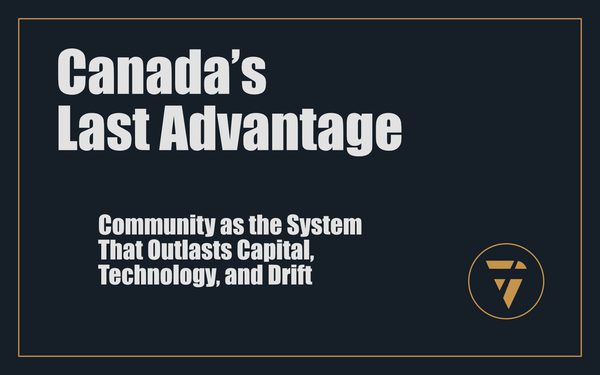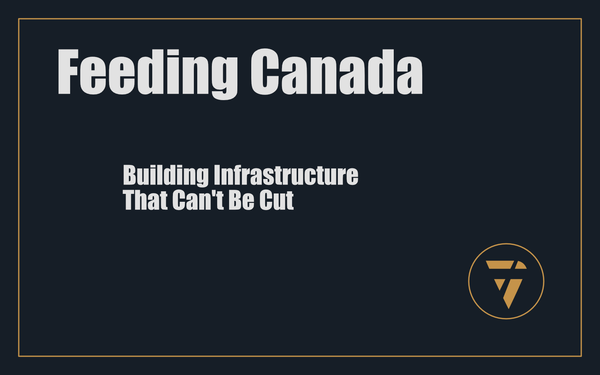Investing in Independence

Indigenous-Led Economic Development Creates Lasting Prosperity
Indigenous, remote, and rural communities have long been the backbone of Canada’s economy, providing resources, labour, and cultural richness to the national landscape. Yet, when it comes to economic development, these communities have historically been underfunded, underserved, and overlooked. Many still face limited access to infrastructure, financial resources, and investment opportunities, creating barriers to self-sufficiency and sustainable growth.
Economic self-sufficiency is not just about financial stability, it's about empowerment, resilience, and the ability for communities to control their own future. When we build strong, locally driven economies, we gain the power to preserve culture, create employment, and sustain long-term prosperity without dependence on outside intervention.
1. How Economic Self-Sufficiency Strengthens Indigenous and Rural Communities
Economic development is more than job creation, it's about giving communities control over their own future. Without self-sufficiency, these regions often face a cycle of economic dependence, relying on government support, external corporations, or seasonal industries that don't offer long-term stability.
The Benefits of Economic Self-Sufficiency
1. Increased Community Control
- When a community owns its businesses and industries, it dictates its own economic policies, rather than being at the mercy of external forces.
- Decisions on land use, resource management, and investment are made by the community, for the community.
2. Preservation of Culture and Traditions
- Indigenous-led businesses and economic initiatives provide opportunities to integrate traditional knowledge and practices into modern industries.
- Economic independence allows communities to fund cultural programs, language preservation, and heritage initiatives without relying on outside funding.
3. Job Creation and Workforce Retention
- Many Indigenous and rural areas struggle with youth migration, as younger generations leave to find job opportunities in urban centres.
- Strong local economies provide employment pathways that keep talent within the community.
4. Long-Term Financial Stability
- Economic self-sufficiency reduces dependence on unstable government funding or external corporations that may pull out when profits decline.
- Community-owned enterprises, co-operative models, and revenue-generating projects provide consistent funding for education, healthcare, and infrastructure.
Despite these benefits, achieving economic independence remains a challenge due to historical inequalities, lack of access to capital, and bureaucratic barriers. However, many Indigenous, remote, and rural communities have successfully navigated these challenges to create sustainable, community-driven economies.
2. Case Studies of Successful Indigenous-Led Development Initiatives
Across Canada, Indigenous communities are taking bold steps toward economic self-sufficiency by developing their own businesses, industries, and investment strategies. These initiatives serve as models for other regions looking to take control of their economic future.
Case Study 1: First Nations-Led Renewable Energy Projects
Many Indigenous communities have turned to renewable energy as a pathway to economic independence. By investing in solar, wind, and hydroelectric power, they not only create jobs but also generate long-term revenue streams.
Example: The Wataynikaneyap Power Project
- A partnership between 24 First Nations in Northern Ontario, this project is building a 1,800-kilometre transmission line to connect remote communities to the power grid.
- Previously, these communities relied on expensive diesel generators for electricity, limiting economic growth.
- With this project, communities gain ownership over their energy infrastructure, ensuring long-term energy security and economic benefits.
Case Study 2: Indigenous Tourism and Cultural Enterprises
Tourism is a powerful tool for Indigenous economic development when it is community-led and designed to respect and promote cultural traditions.
Example: The Haida Enterprise Corporation (HaiCo)
- The Haida Nation created HaiCo to develop tourism, fisheries, and forestry businesses while protecting cultural and environmental values.
- HaiCo’s tourism ventures, including luxury eco-lodges and guided cultural experiences, provide employment while educating visitors about Haida traditions.
- The revenue from these businesses is reinvested into Haida language revitalization, housing, and community programs.
Case Study 3: Indigenous-Led Land Development and Housing Initiatives
Many Indigenous communities are addressing the housing crisis by developing their own real estate and construction industries.
Example: First Nations Market Housing Fund
- This initiative provides loan guarantees for homeownership and community infrastructure, allowing First Nations to build and manage their own housing developments.
- Instead of relying on government-funded housing, communities are generating their own capital and investment structures.
- This approach not only creates jobs in construction and property management but also strengthens economic independence.
Each of these case studies demonstrates the power of Indigenous-led economic strategies, but for many communities, accessing capital and investment remains a major challenge. This is where MEDA plays a crucial role.
3. The Role of MEDA in Aligning Investment with Indigenous Priorities
Manitou Economic Development Agency (MEDA) specializes in connecting Indigenous and rural communities with capital, investment opportunities, and economic strategies that align with their long-term priorities.
How MEDA Supports Indigenous and Rural Economic Development
1. Access to Funding and Investment
- Many Indigenous communities struggle to secure funding due to bureaucratic barriers and restrictive lending policies.
- MEDA works to structure financing models that blend government grants, private capital, and community investment funds.
2. Supporting Indigenous-Owned Enterprises
- MEDA helps identify viable business opportunities, create business plans, and structure investment partnerships that ensure long-term profitability.
- Focus areas include tourism, energy, agriculture, housing, and digital industries.
3. Infrastructure Development
- Many Indigenous and rural communities lack the infrastructure needed to support business growth.
- MEDA secures funding and partnerships to develop roads, broadband, utilities, and commercial spaces.
4. Regulatory Navigation and Policy Advocacy
- Indigenous businesses often face complex legal and policy hurdles when launching new ventures.
- MEDA works with communities to streamline the approval process, advocate for policy changes, and structure projects for success.
The Future of Indigenous and Rural Economic Development
Indigenous, remote, and rural communities are no longer waiting for outside investment, they are building their own economies, reclaiming control over their industries, and creating sustainable prosperity.
The path forward requires strategic partnerships, access to capital, and infrastructure investment, but the foundation for economic self-sufficiency is already being laid.
Manitou Economic Development Agency is committed to helping Indigenous, remote, and rural communities turn economic independence from a vision into reality. Through funding access, business support, and infrastructure development, MEDA ensures that communities have the tools they need to create lasting, community-driven prosperity.
The future belongs to those who build it themselves, who's ready to take the next step?
This is what I’m working on. Tell me what you think, I enjoy the conversation! Subscribe and follow the work in real time.
Thanks!
B

Indigenous, remote, and rural communities are not waiting for outside investment, they're building their own economies, reclaiming industries, and driving sustainable growth. Economic self-sufficiency is the future. Who’s ready to invest in resilient independence?
PS -






